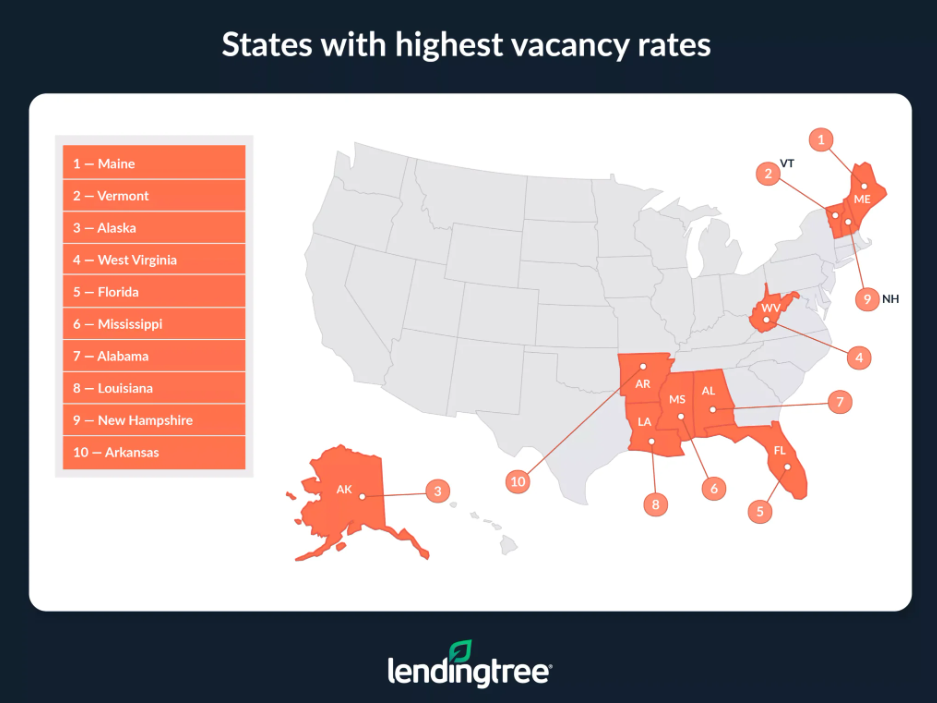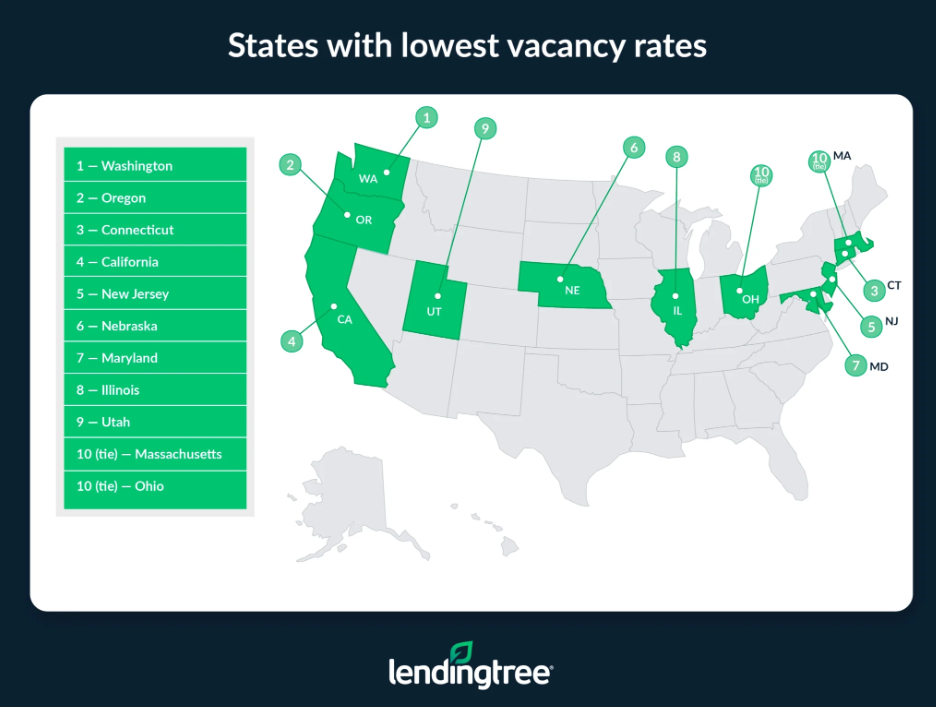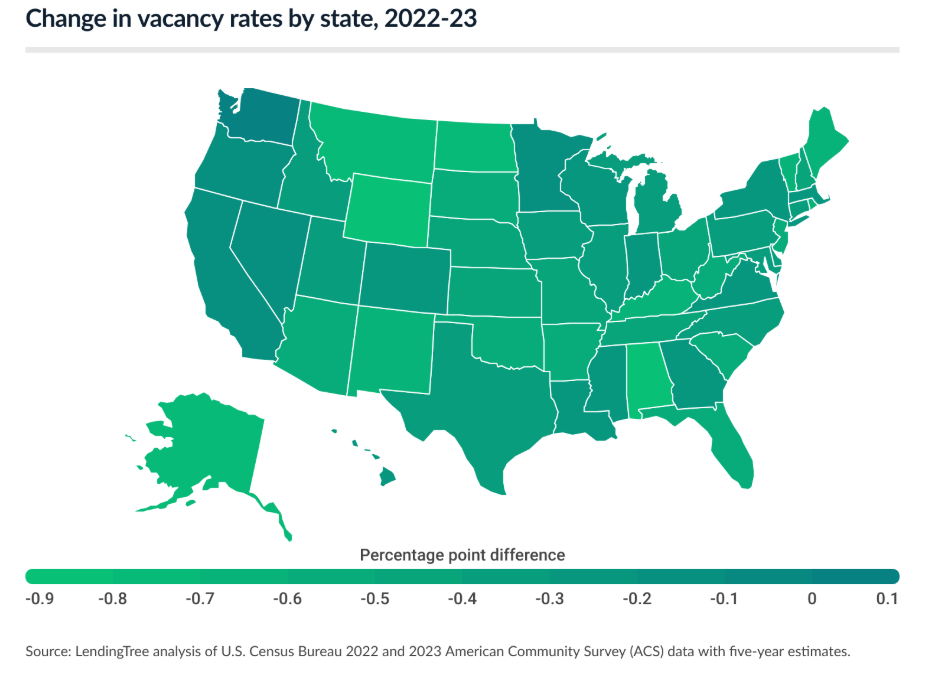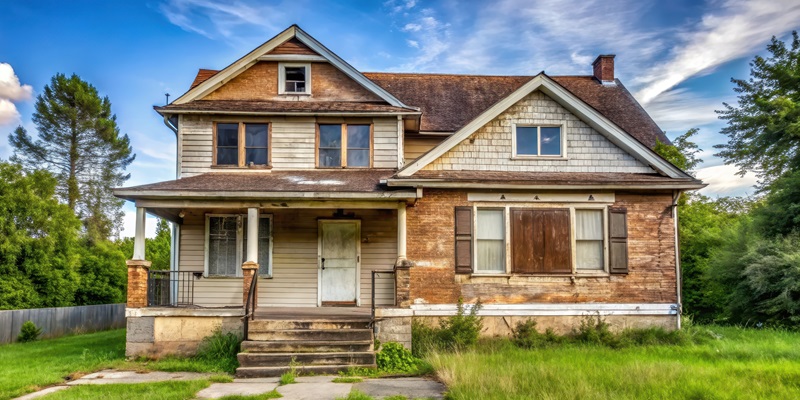Home vacancies are more than just empty real estate: they can be barometers of the real estate market. High vacancy rates can mean oversupply or declining demand, leading to lower property values and slower economic growth. But for renters, this can be a good thing, as declining demand can drive down prices and offer a better shot at homeownership. A recent LendingTree study analyzed US Census Bureau data on vacancy rates and home values across the nation to see where the vacancy market stands today, and what it means.
Key Findings
- The highest vacancy rates are in Maine (21.09%), Vermont (20.06%), and Alaska (18.24%)—nearly 285,000 vacant homes combined.
- The lowest vacancy rates are in Washington (7.42%), Oregon (7.46%), and Connecticut (7.54%). Collectively, these states have over twice as many vacant homes (495,000) as Maine, Vermont, and Alaska combined.
- Vacancy rates are down in every state but one: Washington. Vacancy rates fell 0.36 percentage points between 2022 and 2023, with Wyoming (0.89), Alabama (0.85) and North Dakota and Montana (both tied at 0.77) leading the way. Washington’s rates rose by 0.05.
- Low vacancy rates seem to correlate with significantly higher median home values. The median home values average of the 10 states with the lowest vacancy rates was $408,382, yet that value was $247,850 in the 10 states with the highest vacancy rates.
Highest Vacancy Rates: Maine, Vermont & Alaska
Maine has the highest vacancy rate in the country (21.09%, or 157,467 vacant homes), followed by Vermont (20.06%, 67,606 vacancies), and Alaska (18.24%, 59,745 vacancies). Those three account for 285,000 vacant homes out of 14.9 million vacant homes nationwide (5.6 million homes are vacant in nation’s largest metros.

One of the big reasons for these higher vacancy rates is in the Census Bureau’s definition of a vacant house. More than just an empty house, a “vacant house” includes seasonal, recreational, and occasional use homes. The top three states with the highest vacancy rates (Maine, Vermont, Alaska) all have a sizable percentage of these types of those properties.

The national average vacancy rate is 10.43% (15 million vacant homes), much lower than those three states. But not all those properties are available to rent or buy.
And then there are the inbetweener homes, houses classified as vacant because they’re in transition: rented but not occupied, sold but not occupied. Migrant worker homes occupied only during crop season also fall in this category.
Lowest Vacancy Rates: Washington, Oregon & Connecticut
Washington leads the lowest vacancy rate in the country with 7.42%, followed by Oregon (7.46%) and Connecticut (7.54%). Ironically, the combined number of vacant homes in these three states is significantly higher than in the states with the lowest vacancy rates. So low-vacancy Washington has 242,109 vacant homes while high-vacancy rate Maine has 157,467 vacancies. A lot of it comes down to a state’s total housing inventory; those with the lowest vacancy rates have far larger housing inventories than those with the highest vacancy rates.

Vacancy Rates Dip Slightly YoY
Overall, the U.S. vacancy rate fell 0.36 percentage points between 2022 and 2023, due to interest rates, says Matt Schulz, LendingTree chief consumer finance analyst and author of Ask Questions, Save Money, Make More: How to Take Control of Your Financial Life.
“During 2022 and 2023, the Fed was extremely busy raising rates in an attempt to combat inflation,” he says. “Mortgage rates rose sharply during that time, and those increases meant people were much more likely to stay put in their current home than to shop around for somewhere else to live.”
Wyoming saw the biggest percentage point decrease (0.89), followed by Alabama (0.85) and North Dakota and Montana (both 0.77).

And then there’s Washington, the only state to see its vacancy rate increase with (+0.05)—but with the lowest vacancy rate in the country, it has the breathing room.
States With Low Vacancy Rates Have Higher Home Values
Median home values averaged $408,382 across the top 11 states with the lowest vacancy rates; contrast this with the 10 states with the highest vacancy rates where median home values averaged $247,850 (due in part to varying average incomes and populations between states).
“Bigger incomes likely mean a wider variety of options as to what exactly they can afford, even with housing prices that are higher than in other locations,” Schulz says.
Click here for more on LendingTree’s analysis of the nation’s vacancy rates.








